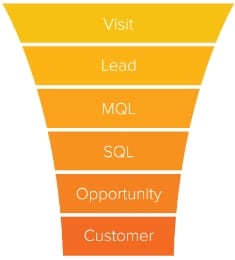B2B selling is expensive.
Sales cycles are long, typically 3 months to longer than a year, sales staff resourcing is high and even just creating the proposal can take hours, or in some cases, hundreds of hours.
For B2B businesses, lead nurturing is important to move leads through the Buyer’s Journey, but Lead Qualification is critical to ensure you only invest your time in the highest priority leads.
Right up front, it’s important to acknowledge lead qualification is a probabilistic task.
You remember the scene from Pretty Woman, I’m sure.
Shop assistant: “Hello, can I help you?”
Vivian: “I was in here yesterday, you wouldn’t wait on me.”
Shop assistant: “Oh.”
Vivian: “You people work on commission, right?”
Shop assistant: “Yeah.”
Vivian: “Big mistake. Big. Huge. I have to go shopping now.”
While there is no excuse for the way Vivian was treated in this encounter, every prospect, customer and person, should be treated with respect, the idea that you should focus more time and effort on higher probability prospects is sound.
You may miss the 1 in 1000 leads that didn’t qualify and then bought elsewhere, but you will convert far more overall sales by focusing on the 999 that do qualify.
Hot Links to Key Topics In this Post
- What is Lead Qualification
- Why you Need to Qualify Leads
- Steps in Qualification
- MQL->SQL Qualification
- SQL -> Opportunity
- Closing the Sale
What is Lead Qualification
Lead Qualification is the act of assessing each sales lead and allocating scarce resources to those which have the highest probability of converting to a customer.
Or, put another way, chase the good leads hard and put the others on the back burner.
Why you Need to Qualify Leads
I have already alluded to it, but the most important reason for qualifying leads is to ensure you allocate resources to maximum possible effect.
Sales focus
It is legendary that sales staff say marketing provide low quality leads, and marketing complain because sales never properly follow up on the leads they are provided.
Actually, it’s not a legend: According to ReachForce and Marketo Sales reps ignore 50% of marketing leads!
A good lead qualification process ensures both teams understand, and agree on what constitutes a qualified lead. Thus, sales are more likely to purse all leads provided and marketing provide only qualified leads.
This process is also a virtuous circle: as sales become more confident in the leads they are assigned, they will work them harder and convert more to customers.
Applying resources to the highest value task
Everyone likes to be nice but spending time on leads that will never, or very rarely, convert is charity not business. A properly run lead qualification process ensures sales focus on leads with the highest probability of converting to customers.
MarketingSherpa found that 61% of B2B marketers send all leads directly to Sales; however, only 27% of those leads will be qualified. That means 73% of sales time is not being used effectively.
But a well-executed lead qualification process ensures that you are applying the right resources in the right place.
Steps in Qualification
Most qualification approaches include steps between “stranger” and “customer”. The most common steps are below:

Visitor: someone who has visited your website site or location. You don’t know much about them at all.
Lead: A lead has interacted with your site a little and has probably downloaded or requested some information via an inbound marketing form.
MQL: A Marketing Qualified Lead has likely downloaded more than one piece of information and may have visited the site more than once. An MQL is normally managed using B2B marketing automation and so is still relatively inexpensive to support.
SQL: A Sales Qualified Lead has also downloaded more than one piece of content and/or the content they have consumed indicates a higher likelihood of buying. For instance, pricing pages, About Us pages, purchasing guides. Once a lead converts to SQL their management cost increase significantly as a sales person or inside sales person will be assigned to personally manage the lead.
Opportunity: The sales person has contact the lead and determined a real opportunity exists.
Customer: The ultimate goal — the person or company has made a purchase.
Of all these steps the most important lead qualification steps are MQL -> SQL and SQL -> Opportunity.
Moving to SQL and Opportunity rapidly ramp up the cost of servicing the lead. These are the places you need to take the most care.
Let’s explore both of those transitions.
MQL->SQL Qualification
For this lead qualifying step, marketing and sales need to be in close agreement on, exactly, constitutes an SQL. In addition, much of the pre-work can be automated or simple rules based.
Marketing might need to do a little data enrichment to ensure only properly qualified leads move to the next stage but that is generally simple and low cost. For instance, validating against a LinkedIn profile or company website, etc.
The key areas to review and agree between Marketing and Sales are:
Buyer Persona
You should be clear on the important buyer personas for your business.
Much like the Pretty Woman discussion above, some prospects are simply more likely to buy than others. Make sure you understand what a high probability lead looks like.
In this step Marketing should assign each lead to a specific Persona. For many businesses this can be done by collecting job title or role information as the lead requests information.

Behavioural attributes
Is the lead exhibiting the behaviour of a high potential lead?
Do they come back often, read multiple pages, look at the About Us or pricing pages?
Your website statistics can assist in this process, as can a well-organized marketing automation system.
Put Up Barriers
One way to drive a high conversion process on your landing pages and lead collection forms is to reduce the information you request to just a couple of items or even just “email address”.
This gets you way more contacts (quantity), but not necessarily more good leads (quality).
The more information you ask, the higher the barrier to access, the fewer tire kickers will bother to fill out the form.
So, for conversions further along the Buyer Journey increase the information you request, but make sure it is still relevant. The leads that persevere in the face of higher barriers will likely be more qualified.
Consider What They Download, Request and View
If you are a software company, a prospect that has viewed your pricing page before they request a demo will be a better qualified lead as they know your fee levels.
Visitors that have seen your About Us page are similarly more likely to be a good lead as they are further along the buyer’s path.
Prospects that have downloaded bottom of the funnel content such as buyer’s guides are more likely go SQL than those that have looked only at top of the funnel blog posts.
Prospect Fit
Particularly in B2B, Prospect Fit will be a major factor in ruling them a lead out of SQL.
The CEO of a 10 person company asking for a meeting to discuss your Human Resources professional services package starting $1,000,000 has a lower Prospect Fit than the CEO of a 1,000 person company.
A company that has never spent a dime on marketing is not likely commit to your $250k TV advertising campaign without a long process.
Creating a Lead Score
Typically, organizations use a points based system to accumulate all of the factors into a single Lead Score. When prospects breach a minimum score they convert to SQLs.
For instance:
- +5 points for a demo request
- -20 points if the job title is “consultant”
- +20 points if the job title is “CEO” or “COO”
- etc.
These work well and are easy for Sales and Marketing to agree, and agree they must.
You should also consider “veto” conditions, e.g. staff size of less than 50, that, no matter how good the rest of the indicators, prevent a lead going SQL.
The exact point scores need to be developed over time and should be continually improved based on actual sales performance, i.e. how many SQL leads finally buy.
This can be difficult in smaller organization (fewer sales) or ones with very large (lumpy) sales or long lead times but your best estimate will be better than no estimate at all.
SQL -> Opportunity Qualification
Now the lead has been SQL’d and the initial conditions for a sale have been met, the second stage of qualification occurs.
In this step the sales person contacts the prospect and determines whether there is a concrete business opportunity.
The qualification stage is needed because 50% of leads are qualified but not yet ready to buy. (Source: Gleanster Research). You need to ensure they are ready to buy before investing at the next level.
There are a number of frameworks for this process: BANT, CHAMP, MEDDIC
Each framework attempts to uncover if the prospect is ready, willing and able to make the purchase. The job of the sales person is to ask questions and make this determination early in the sales engagement to qualify in the right prospects and qualify out the wrong prospects.
By reviewing the answers to each of these questions the sales person can qualify, or disqualify, the lead and move them to Opportunity status.
BANT has been used for many years, by many organizations, but the weight of opinion is that that CHAMP, an evolved version of BANT, is a better way to go these days. So we’ll explore CHAMP.
CHAMP stands for:
(CH)allenges
Before any business makes a purchase, they must have a challenge (or problem) that needs to be solved. While consumers will often make impulse purchases, this occurs much less often in businesses.
To pass the (CH) part of the qualification process the sales person must uncover whether the business has a challenge and acknowledges it.
The last part is important. Even if the sales person thinks (or knows) the prospect has a problem, if the prospect doesn’t acknowledge it, they don’t.
To uncover challenges the sales person can ask…
- Are you happy with the [solution/product/service] you are using now? Why? Why not?
- What improvements would you like to make in [this area] of your business?
- What is holding you back from achieving your goals this quarter?
(A)uthority
Authority relates to the authority the prospect has to make a purchase decision.
If your MQL-SQL qualification process is working well, you should only be dealing with Buyer Personas that have purchasing authority for your type of business.
However, you need to validate this by asking the prospect some questions about the decision-making process:
- Whose budget will be used for this purchase?
- Does anyone else need to approve this purchase
- Are there other people in the organization who will need to give their okay for this purchase?
(M)oney
This is a crucial element of the purchase decision. If there is no money, there is no sale.
It’s always been my experience that if you are dealing at a senior level (typically “C” level) then budget is less of a problem because, if the value you are offering is high enough, they will find the budget.
However, for smaller purchases or at a lower level in the organization, budgets will become an issue.
This qualification element determines if there has been budget set aside for this purchase, or if budget from another task can be allocated to it.
- Have you budgeted for this purchase this year?
- (if not) when does your financial year start and can you put it into that budget?
- Have you set aside a budget for this project?
(P)riority
The most precious resource that a busy executive has is not money, it is time.
There is never enough time to complete all the tasks they would like to and so they must prioritise. (Just as you are with lead qualification.)
You can offer a great service, that delivers terrific value, and it may be budgeted but if something else is more important nothing will happen.
To move forward, your purchase must bubble to the top of the pile. It must become, at least for a short while, a burning platform for the person making the decision.
So you need to know where in the list your particular project sits.
You can ask:
- Where does this project sit in your priority list?
- Do you need to clear the decks to start or is this project at the top of the list?
- What else is competing for your time right now? Is this issue the most important task at the moment?
Closing the Sale
Of course, a good qualification process does not obviate the need for selling.
You still need listen to and understand the customer’s need and present them with the right solution. If you do that you have every right to be part of the final decision.







